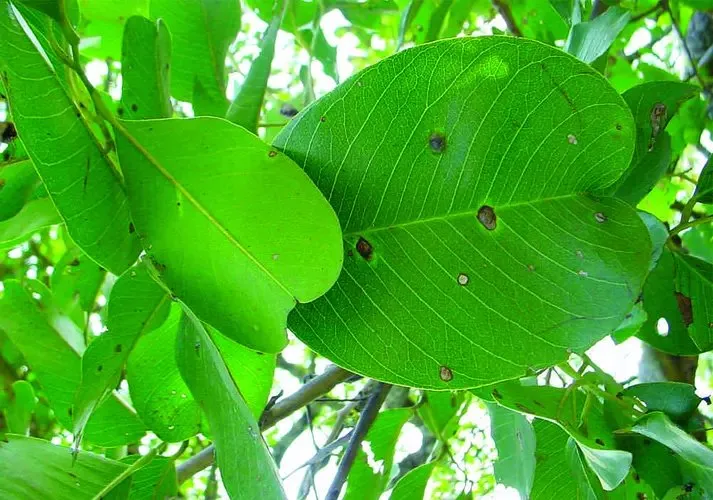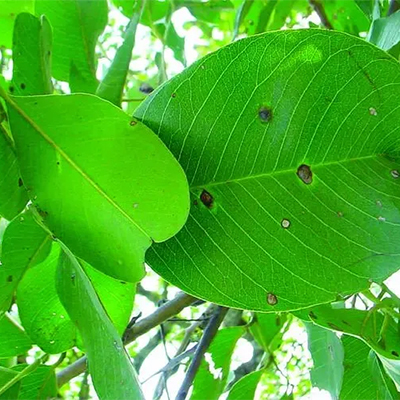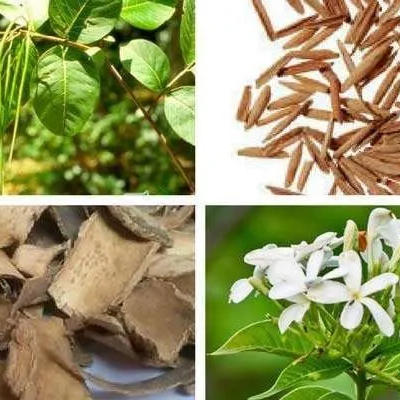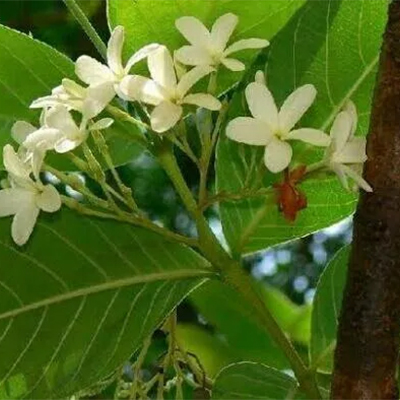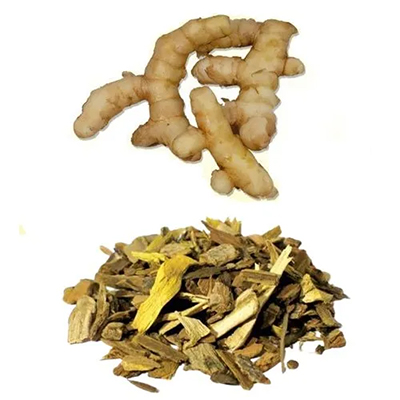On This Page
Bijaka- The Indian Kino tree
Introduction
Bijakaor Asana commonly known as Vijayasara or Honne Mara in Kannada is widely distributed in several regions of India. It is botanically known as Pterocarpus marsupium Roxb. And belongs to the Fabaceae family. Bijaka is a deciduous medium to large tree which has dark brown or gray-black swallow cracks and exudes a gummy substance that is red and known as Kinno. In Ayurvedic classical texts, various information is available regarding this plant. Acharaya Charaka mentioned Bijaka under Udarad Prashmana Mahakashaya and Shirovirechno Upyogi, whereas Acharaya Sushruta mentioned it under Shaalsaaradi Gana. Controversy is also there regarding Bijaka i.e some authors consider Asana and Bijaka different drugs, and Asana is considered as Terminalia tomentosa while some authors consider Bridelia montana as Asana. Professor Singh, Famous for Dravyaguna literature suggests that real Asana is Pterocarpus marsupium and Terminalia tomentosa can be used as its substitute. This controversy concludes that Bijaka and Asana are the same and should be considered Pterocarpus marsupium. Recent research revealed that Bijaka consists of chemical constituents like epicatechin, pterosupin, kino tannic acid, etc due to which it exhibits anti-inflammatory, cardiotonic, analgesic, antidiabetic activities, etc. As per Ayurveda Bijaka is Kashaya (astringent) and Tikata (bitter), which have a cold potency and are used to treat various disorders like Parmeha (diabetes), Kustha (skin disorder), Medo Roga (obesity), etc.
Basonym of Bijaka – Asana – Vijayasara
असन – अस्यति क्षिपति प्रमेहादीन् रोगान, अस्यन्ते विकीर्यन्ते फलानि च सपक्षत्वात्|
Bijaka is very much beneficial in Prameha Roga and fruits are spread over a large area as it is a large tree.
बीजक – फले बीजस्वैव प्राधान्यात् |
Seeds appear prominent in a fruit.
Synonyms of Bijaka – Asana – Vijayasara
- According to Habitat
शौरि: – शूरे शूरसेनप्रदेशे भव: ।
Bijaka commonly grows in Sura Sena Pradesh (Western Uttara Pradesh).
- According to Habitat
पीवर: – स्थूल काण्डत्वात् |
The trunk of the Bijaka is very large.
महासर्ज: – महान् वृक्ष: सर्जकार: |
Bijaka is a big tree like that of Sarja (Vateria indica).
तिष्य: – तिष्ये पौष्यमासे पुष्यति |
Bijaka blossoms in Pushya Masha (late winter).
सुगन्धि – पुष्पाणां सुगन्धित्वात् |
Flowers are aromatic.
पीतसार: – पीतवर्ण: सरो अस्य ।
The heartwood of Bijaka is yellow.
पीतशालक: – पीतसार: शाल सदृश: |
Heartwood is yellow and resembles the heartwood of Sala (Shorea robusta).
- According to properties and action
कार्श्य: – कृश तव जनक: |
Beejaka is Kaarshya Kara (emaciating).
Regional names of Bijaka – Asana – Vijayasara
- Indian Kino tree, Malabar Kinno (English)
- Vijayasara, Bijosara (Hindi)
- Pitshal, Piyashal (Bengali)
- Honnemara (Kannada)
- Venga (Malayalam)
- Bihala, Vivla (Marathi)
- Dambhaul- Akhvain (Arabic)
- Bhengai (Tamil)
- Pedagi (Telugu)
- Bia (Gujarati)
- Chandanlal, Channalal (Punjabi)
Botanical Name
Pterocarpus marsupium Roxb.
Pterocarpus- Ptero means with wings, Carpus means fruit.
Marsupium means bears pouch in flowers (purse-like)
Family
Papilionaceae/ Fabaceae (Aparajita Kula)
Ayurveda reference for Bijaka – Asana (Pterocarpus marsupium Roxb.)
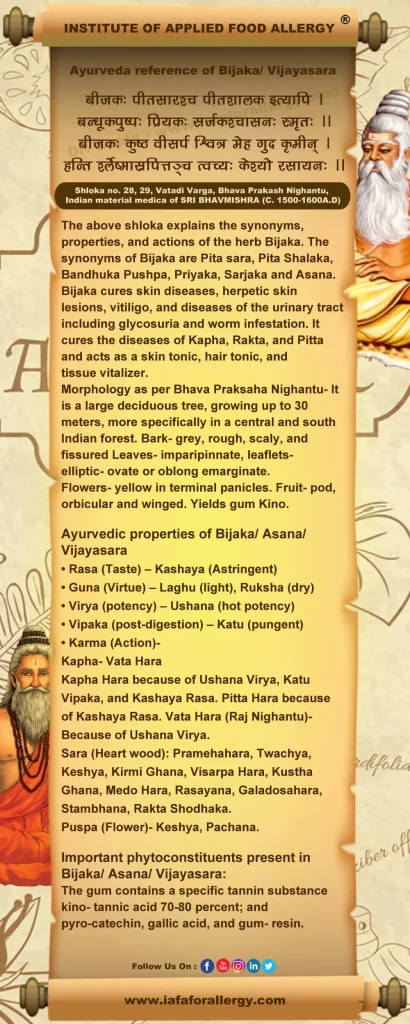
Scientific classification of Bijaka – Asana – Vijayasara
| Kingdom | Plantae |
| Class | Dicotyledons |
| Subclass | Polypetalae |
| Series | Calyciflorae |
| Order | Rosales |
| Family | Papilionaceae (Fabaceae) |
| Genus | Pterocarpus |
| Species | marsupium |
Classification of Bijaka – Asana – Vijayasara as per Charaka and Sushruta
- Charaka: Udarda Prashmana Maha Kshaya, Shiro Virechnopyogi
- Sushruta: Saalsaradi Gana
Bijaka’s description in Brihtrayi
Bijaka is one of the names of Pterocarpus marsupium Roxb. popularly known as Bija, Biyu, and Vijayasara. It appears that for the sake of avoiding confusion with the word Bija (seed), this name was not used very frequently, and instead, its synonym Asana was in common use. It is wrong to think that Asana and Bijaka are two different plants.
| Charaka | Shusruta | Vagbhata
(Ashtang Hridya) |
| C. S. Chi. 16/ 106 | S. S. Chi. 6/ 19 | A. H. Chi. 3/ 134 |
| S. S. Chi. 9/ 50 | A. H. Chi. 5/ 28 | |
| S. S. Chi. 25/ 28, 32, 33 | A. H. Chi. 20/ 8 | |
| S. S. Chi. 27/ 11 | A. H. U. 39/ 150, 153 | |
| S. S. U. 10/ 8 | ||
| S. S. U. 23/ 4 |
Bijaka’s description in Brihtrayi as synonym Asana
Asana has now been identified with Bijaka, as has been invariably done by Dalhana. It is believed by some that Asana and Bijaka are two different drug plants, but the following facts make it abundantly clear that they are only two names given to the same plant known as Pterocarpus marsupium Roxb.
- Bijaka and Asana have been replaced by each other in identical Yogas. Compare Udarda Prasamana group of drugs of Caraka and Astanga Samgraha.
- Asana Niryasa has been mentioned as Shiro Virechana Dravya by Caraka (Vi. 8. 158). Niryasa or the natural gummy exudation is found in Pterocarpus sp. but not in Terminalia sp. or Bridelia sp. which are supposed to be Asana by others.
- In Kustha and Meha, Asana- Sara has been used more frequently and Asana has been included in the Salasaradi or group of drugs which is exclusively a group of wood drugs useful in Kustha and Meha. If Bijaka were different, its exclusion from this group and its scarce mention in the chapter on Kustha could not be reasonably explained.
| Charaka | Shusruta | Vagbhata
(Ashtang Hridya) |
| C. S. Su. 4/ 43 | S. S. Su. 6/ 37 | A. H. Su. 15/ 7, 19 |
| C. S. Su. 5/ 70 | S. S. Su. 38/ 12 | A. H. Sa. 1/ 13 |
| C. S. Su. 25/ 49 | S. S. Su. 46/ 284 | A. H. Chi. 12/ 14, 29 |
| C. S. Vi. 8/ 151, 158 | S. S. Chi. 9/ 6 | A. H. Chi. 19/ 24, 37 |
| C. S. Vi. 8/ 144, 151 | S. S. Chi. 10/ 4, 9 | A. H. Chi. 20/ 5 |
| C. S. Chi. 1. 2/ 12 | S. S. Chi. 11/ 9 | A. H. U. 2/ 74 |
| C. S. Chi. 1. 3/ 2 | S. S. Ka. 3/ 9 | A. H. U. 13/ 46 |
| C. S. Chi. 1. 4/ 12 | S. S. U. 39/ 252 | A. H. U. 22/ 72 |
| C. S. Chi. 3/ 257 | S. S. U. 41/ 50 | A. H. U. 24/ 38 |
| C. S. Chi. 4/ 93 | S. S. U. 45/ 34 | A. H. U. 28/ 42 |
| C. S. Chi. 6/ 31 | A. H. U. 39/ 105, 107, 149, 152, 155, 169, 174 | |
| C. S. Chi. 7/ 100, 151 | ||
| C. S. Chi. 27/ 54 | ||
| C. S. Ka. 1/ 7 |
Historical background of Bijaka – Asana – Vijayasara
It is a tree that attains a height of 15 meters and possesses yellow flowers. It grows in almost all the forests in India. Among Brhattrayi Sushruta used it abundantly. It is described with the names Priyaka in C. S. Su. 25/ 40 & S. S. Ut. 47/ 61. Some consider it as the synonym of Kadamba. During the Nighantu period, its utility has increased and at present, it is considered one of the potent anti-diabetic drugs of herbal origin.
External morphology of Pterocarpus marsupium
- Habit- Moderate to a tall-sized deciduous tree grows 30 meters in height and 2.5 meters in girth with a straight clear hole. Asana is a large deciduous tree with a stout crooked stem and widely spreading branches; bark thick; yellowish-grey; the outer layer corky.
- Heartwood- Golden brown or reddish-brown colored with darker streaks, strong, tough, and moderately heavy.
- Leaves- Compound imparipinnate, leaflets 5-7 coriaceous, oblong to obtuse glabrous on both surfaces. Leaves 15-25 cm. long, Rachis glabrous, prolonged 2- 2.5 cm. beyond the insertion of the upper lateral leaflet. Leaflets 5- 7, coriaceous, 6.5- 10 by 3- 8.5 cm. oblong, obtuse, rounded, truncate or more or less retuse at the apex, glabrous on both surfaces, shining above, base subacute; main nerves numerous; close prominent; petiolules 6-10 mm. long
- Inflorescence- terminal panicle.
- Flower- Pale yellow petals are 1-1.5 cm long. Flowers in short lateral and terminal Fusco-pubescent paniculate racemes, usually shorter than the leaves; pedicels short, articulated, beneath the flower. Calyx 6 mm. long, veined, brown- pubescent; teeth very short, broadly triangular; the upper the largest. Corolla 1.5 cm., long, pale yellow with crisp margins; standard 11 mm. broad, with a long claw. Stamen Monadelphous or the staminal tube often finally slit on both sides, making them diadelphous. Ovary shortly stalked; ovules 2.
- Fruit- Pod, 2.5-5cm in diameter, nearly circular, glabrous, with wings.
- Seed- The seed is small.
Flowering and fruiting time
Autumn – winter season
Distribution of Bijaka – Asana – Vijayasara
It is found in the Western Peninsula and Southern India, and Ceylon. Especially found in central and southern India, Tamil Nadu, Bihar, and other areas in the country.
The useful part of Bijaka – Asana – Vijayasara
Heart wood, Gum.
Sara (Heart wood)- Heartwood pieces will be rectangular or square-shaped, 2 to 3 cm thick. Surface yellowish red with a golden hue, marked with dark streaks and parallelly running striation which represents annual rings. The drug also occurs as curved shavings of brownish-red color. Very difficult to break and it is brittle. Has phenolic characteristic odor. The taste is astringent followed by a bitter aftertaste.
Substitute and adulterant of Bijaka – Asana – Vijayasara
In certain areas of the country, Terminalia tomentosa is used as a substitute (Pratinidhi Dravya) for Pterocarpus marsupium.
Bengal Kinno is the dried juice of Butea monosperma Taub. The trunk is used as the adulterant as well as a substitute for Bijaka.
Important phytoconstituent of Bijaka – Asana – Vijayasara
The gum contains a specific tannin substance kino- tannic acid 70-80 percent; and pyro-catechin, gallic acid, and gum- resin.
Recent research on Bijaka – Asana – Vijayasara
- Extract of heartwood showed significant hypoglycemic action in fasting rabbits 3 and 5 hrs. after oral administration (I.J.M.R, 1967, 55, 166).
- Alcoholic extract of the stem significantly lowered blood sugar and improved glucose tolerance of rabbits (J. Res. Ind, Med. 1971, 6, 205).
- Epicatechin, when given before or within 24 hrs. after alloxan, reversed hyperglycemia in alloxan-diabetic rats (J. Nat. Prod. 1983, 46, 232).
- Epicatechin showed positive chronotropic and inotropic effects on isolated frog hearts which were blocked by propranolol. In higher doses, it caused hyperglycemia in rats and this effect was also blocked by propanol (Planta Med. 1985, 51, 56).
- Administration of ethyl acetate extract for 14 consecutive days to rats produced a significant reduction in levels of serum TGs, total cholesterol, and LDL- and VLDL- cholesterol without any significant effect on the level of HDL-cholesterol (J. Nat. Prod. 1993, 56, 989).
- To fractionate the antidiabetic constituents (S) of the aqueous extract of Pterocarpus marsupium, heartwood (PMB), the antidiabetic constituents of Pterocarpus marsupium demonstrate that a high molecular weight constituent of Pterocarpus marsupium has patent insulin trophic and insulin-like properties. Mohan Kumar SK, O’Shea T, McFarlane JR. Insulin trophic and Insulin-like effects of a high molecular weight aqueous extract of Pterocarpus marsupium Roxb. heartwood. J. Ethnopharmacology 2012 May 7; 141 (1): 72- 9. Epub 2012 Feb 10.
- A flexible-dose open trial was undertaken in four centers in India to evaluate the efficacy of an Ayurvedic drug Vijayasara (P. marsupium) in the treatment of newly-diagnosed or untreated MIDDM. By the 12th week, control of blood sugar (FBS & PPBS) had been attained in 67 (69%) out of 97 patients studied, and the dose at which control was attained was 2 g of the extract in about 13% of the patients, 3 g in about 16% and 4 g in 10% of the patents. Mean HbA1C decreased significantly (P<0.001) to 9.4%; no side- effects were reported (Seshiah, V. Sundaram, et al., 1998).
- The study is designed to investigate the effect of aqueous extract of Pterocarpus marsupium Roxb. on elevated inflammatory cytokine, tumor necrosis factor (TNF)-a in type 2 diabetic rats. Modulation of cytokine TNF- alpha by the Rasayana drug Pterocarpus marsupium is related to its potential anti-diabetic activity. Halagappa K, Girish HN, Srinivasan BP. The study of aqueous extract of Pterocarpus marsupium Roxb. on cytokine TNF- alpha in type 2 diabetic rats. Indian J. Pharmacology 2010 Dec; 42 (6): 392- 6.
- Methanolic extract of Pterocarpus marsupium Roxb (P. marsupium) was administered to both non-diabetic and alloxan-induced diabetic adult female Wistar rats at a dosage of 500 mg/ kg body weight, and its effect was checked on serum and tissue lipids together with corticosterone, estrogen, and progesterone profile. Singh PK, Baxi D, Banerjee, S, Ramachandran AV. Therapy with methanolic extract of Pterocarpus marsupium Roxb and Ocimum sanctum Linn reverses dyslipidemia and oxidative stress in an alloxan-induced type I diabetic rat model. Exp Toxicol Pathology 2012 Jul; 64 (5): 441- 8. Epub 2010 Nov 23.
- The present study was aimed at extensively evaluating the antioxidant properties of an anti-diabetic plant extract of stem bark of Pterocarpus marsupium using various in vitro radical scavenging assays as well as by using liver slice cultures as a model system. Results demonstrate that the whole aqueous extract showed high antioxidant activity in all different assays used and also protected mitochondria against oxidative damage. Mohammadi M, Khole S, Devasagayam TP, Ghaskadbi SS. Pterocarpus marsupium extract reveals strong in vitro antioxidant activity. Drug Discover Ther. 2009 Aug; 3 (4): 151- 61.
- The present study was undertaken to evaluate the cardiotonic activity of aqueous extract of heartwood of Pterocarpus marsupium. Compared to digoxin, a drug with a narrow therapeutic window, Pterocarpus marsupium showed a wide therapeutic window. Mohire NC, Salunkhe VR, Bhise SB, Yadav AV. The cardiotonic activity of aqueous extract of heartwood of Pterocarpus marsupium. Indian J Exp Biol. 2007 Jun; 45 (6): 532- 7.
- Antibacterial activity
- Analgesic activity
- Anti- Bacterial
- Cardiotonic activity
Rasa Panchaka of Bijaka – Asana – Vijayasara
| Rasa (Taste) | Kashaya (astringent), Tikata (bitter) |
| Guna (Virtue) | Laghu (light), Ruksha (dry) |
| Virya (potency) | Sheeta (cold potency) according to Pr. Nighantu/ Ushana Virya |
| Vipaka (post-digestion) | Katu (pungent) |
Dosha Karma of Bijaka – Asana – Vijayasara
Kapha- Vata Hara
Kapha Hara because of Ushana Virya, Katu Vipaka, and Kashaya Rasa.
Pitta Hara because of Kashaya Rasa.
Vata Hara (Raj Nighantu)- Because of Ushana Virya.
Karma (Actions) of Bijaka – Asana – Vijayasara
- Sara (Heart wood): Pramehahara, Twachya, Keshya, Kirmi Ghana, Visarpa Hara, Kustha Ghana, Medo Hara, Rasayana, Galadosahara, Stambhana, Rakta Shodhaka.
- Puspa (Flower)- Keshya, Pachana.
Prayogarha Vyadhi (Therapeutic indication) of Bijaka/ Asana/ Vijayasara
- Abhyantra Paryoga (Internal indication): Parmeha, Madhumeha, Mutra- Basti Vikara, Atisara, Pravahika, Krimi Roga, Stri- Bala Atisara, Rakta Vikara- Rakta Pitta, Aamvaata, Sandhi Vata, Vata Rakta, Kustha, udarda, Visarpa, Kesha Vikara, ABhighata, ABhighataja Vedana, Dourbalaya, Dhatu Kshaya.
- Bahya Paryoga (External indication): Tvaka Vikara, Shotha, Visarapa, Shwitra, Danta Shula, Abhighatjanya Peeda, Kesha Vikara, Palitya, Kustha.
Aamyik Paryog (Therapeutic uses) of Bijaka – Asana – Vijayasara
Prameha (Diabetes):
- Being an important member of the Salasaradi Gana, it is useful in Kustha, Prameha, Pandu, and excess of Kapha and Medas (obesity). (Sushruta Samhita Sutra Sthana. 38/ 9)
- Kwatha of Peepala, Patha, and Bijaka is used in the case of Pittaja Parmeha. (Charaka Samhita Chikitsa Sthana. 6/ 32)
As Rasayana (rejuvenator): Decoction of Bijaka, made linctus-like by heating is mixed with Triphala, sugar, honey, and ghee and taken regularly. It is useful in senility. (Ashtanga Hridya Uttara Tantra. 39/ 154, Charaka Samhita Chikitsa Sthana 1. 2/ 12, Ashtanga Hridya Uttara Tantra. 39/ 105)
Medo Roga (Obesity): In obesity, sesamum oil in the morning or decoction of the heartwood of Asana should be taken mixed with honey. (Vaidya Manorma. 12/ 30)
Kustha (Skin disorder):
- Khadira and Bijaka are drugs of choice for Kustha. (Sushruta Samhita Chikitsa Sthana. 6/ 19)
- The Kwatha of Khadir, Daruharidra and Bijaka is used in the case of Pitta Kaphaja Kustha. (Charaka Samhita Chikitsa Sthana. 7/ 101)
Shleepada (Filaria): Intake of the paste. of the heartwood of Khadira, Asana, and Shala with cow’s urine mixed with honey alleviates filaria. (Gada Nigreha. 4. 2. 42)
Upadansha (Venereal wounds): Intake of the decoction of Khadira and Asana as well as the external application of their paste mixed with Guggulu or Triphala destroys all types of Upadamsa. (Vanga Sena. Upadamsa. 24)
Drishti Balarth (For improving vision): Sesamum oil, Bibhitaka oil, Bhrngaraja juice, Asana decoction- all cooked together in an iron vessel and used as snuff improves vision. (Ashtanga Hridya Uttara Tantra. 13/ 46)
Rakta- Pitta (Intrinsic hemorrhage): Alkali of Madhuka and Asana are used in the case of intrinsic hemorrhage. (Charaka Samhita Chikitsa Sthana. 4/ 94)
Shwitra (Vitiligo): One should eat Bhringaraja fried with oil in an iron pan followed by an intake of milk cooked with Bijaka (heartwood). It alleviates vitiligo. (Ashtanga Hridya Chikitsa Sthana. 20/ 8)
Pandu (Anaemia): Bijakasar Arishta is prescribed for anemia. (Ashtanga Hridya Chikitsa Sthana. 18/ 13)
Pascataka: The flowers of asana are dried, powdered finely, and made into pills. One pill is given with rice water to the child suffering from Pascataka. (Vanga Sena. Bala- Roga. 119)
Bhagandra (Fistula in ano): Khadir, Makshika, and Asana Kshaya are used in Bhagandara, Parmeha, Pittika, and Kustha. (Ashtanga Hridya Uttara Tantra 28/ 42)
Benefits of Bijaka – Asana – Vijayasara
- The plant and the gum are hot and bitter with a sharp bitter taste. It is laxative, anthelmintic, and alternative; and it cures Vata and Kapha’s humor in the provocation.
- It cures diseases of the blood, eruptions on the body, leukoderma, erysipelas, urinary discharges, anal troubles, and leprosy; it is useful for eye troubles and elephantiasis.
- The flowers are sweet and bitter, they improve the appetite and may cause flatulence.
- The gum is bitter with a bad taste; it is useful in all diseases of the body. It is styptic, vulnerate, tonic to the fever, antipyretic and anthelmintic; it is good for gripping and biliousness, ophthalmia, boils, gleet, and urinary discharges.
- The gum is used for checking a toothache. It is considered a good astringent in diarrhea and pyrosis.
- The bark of the tree is used as an astringent. The bruised leaves are useful as an external application to boils, sores, and skin diseases.
- The heartwood is effectively used for the treatment of urinary diseases specially Prameha Roga, its decoction is given and considered an efficacious remedy in diabetes.
- The water is kept in a utensil made of wood from the tree for a day or so and the same is regularly drunk by patients with diabetes, and recently the specially designed tumbler (or similar other pots) for drinking Bijaka Jala is employed in certain areas.
- The leaves are bruised or ground for making a paste which is topically applied to various cutaneous affection, dermatosis, eruptive diseases of the skin, inflammation, and other similar skin complaints. For the hair diseases (Palitya), the oil was prepared and applied.
- The heartwood is rubbed (like sandalwood) and it is applied to traumatic pain of the affected organ. The gum of the woods is given for chewing on painful teeth.
- The decoction of heartwood is orally also given in traumatic conditions (including fractures).
- The powder or decoction of the bark is given in worms’ affection. The bark, as well as gum, are internally used in diarrhea and dysentery; and specially indicated for infantile and female ailments of the intestinal tract.
- The heartwood is useful in gout, rheumatic arthritis, and blood diseases.
- The heart-wood is useful as alternative medicine (Rasayana). It is used in obesity, gonorrhea, throat infection, and general debility.
Matra (Therapeutic administration and dosage) of Bijaka – Asana – Vijayasara
- Kwatha (Decoction)- 40- 80 ml
- Churna (powder)- 3- 5 gram

Have A Health Issue?
Consult Online
- Dr. Sahil Gupta (B.A.M.S., M.H.A.)
Ayurvedic Allergy Specialist
CEO & Founder of IAFA®
Classical reference of Bijaka/ Asana/ Vijayasara
Bhava Prakasha Nighantu Vatadi Varga- 28
Synonyms
बीजकः पीतसारश्च पीतशालक इत्यापि |
बन्धूकपुष्प: प्रियक: सर्जकश्चासन: स्मृतः ||
Bhava Prakasha Nighantu Vatadi Varga- 29
Properties and action
बीजक: कुष्ठ वीसर्प श्वित्र मेह गुद कृमीन् |
हन्ति श्र्लेष्मास्रपित्तञ्च त्वच्य: केश्यो रसायन: ||
Dhanwantri Nighantu Aamraadi Varga, 115
बीजक: सकषायश्च कफपित्तास्रनाशन: |
Kaiydeva Nighantu Aushadi Varga, 811- 815
बीजक: कटुक: सोष्ण: कषायः: कफत्तिहा |
त्वच: केश्यो अस्त्र पित्तघ्न: कृमिवीसर्पनाशन: ||
हन्ति कुष्ठ खुड श्वित्र मेदो मेहान् रसायन: |
असनस्य च पुष्पाणि विपाके मधुराणि च ||
तिक्तानि पाचनीयानि वातलानि भवन्ति हि |
Raja Nighantu Prabhadradi Varga, 133
असनः कटुरूष्णश्च तिक्तो वातार्तिदोषनुत् |
सारको गलदोषघ्नो रक्तमण्डलनाशनः ||
Priya Nighantu, Haritkyadi Varga, 128
असन स्तुवरः शीतो रूक्ष: पित्तकफापह: |
स्तम्भनो मेह कुष्ठास्त्र विकारघ्नो रसायन: ||
असनो बीजक: काम्य: प्रियो बन्धूक पुष्पक: |
शीरी: कार्श्यो महा सर्ज: तिष्यो अन्य: कृष्ण सर्जक: |
सुगन्धि नील निर्यास: पुष्प वृक्षो अलक प्रिय: |
Kaiydeva Nighantu Aushadi Varga, 812- 815
असनपुष्पम्
असनस्य च पुष्पाणि विपाके मधुराणि च ||
तिक्तानि पाचनीयानि वातलानि भवन्ति हि |
Dhanwantri Nighantu
बीजकः
बीजक: सकषायश्च कफपित्तास्त्र नाशन: |
असन- सर्जक विशेष:
असनस्तु महासर्ज: सौरिबन्धूक पुष्पकः |
प्रियको बीजवृक्षश्च नीलक: प्रियशालक: ||
Raja Nighantu Prabhadradi Varga, 132
असनगुणाः:
असन: कटुरुष्णश्च तिक्तो वातार्त्तिदोषनुत् |
सारको गल दोषघ्नो रक्तमण्डलनाशनः ||
Raja Nighantu Prabhadradi Varga, 134- 135
नीलबीज:
द्वितीयो नीलबीज: स्यान्नीलपत्र: सुनीलक: |
नील द्रुमो नीलसारो नीलनियासको रसै: ||
गुणा:
बीज वृक्षौ कटु शीतौ कषायौ कुष्ठनाशनौ |
सारकौ कण्डुदद्रु्नो श्रेष्ठस्तत्रासितस्तयो: ||
Charaka Samhita, Chikitsa Sthana, 16- 106/ 111
पाण्डुरोगे बीजकारिष्टः
Shodhala Nighantu, Aamradi Varga
श्लीपदे
खदिरासनशालानां सारकल्क पिबेन्नर: |
प्रातर्गवां हि मूत्रेण सक्षौद्रं शलीपदं जयेत् ||
Vaidya Manorma 12/ 30
स्थौल्य नाशनार्थम्
अतिस्थूल शरीरो यः तिलतैल प्रगे पिबेत्।
पिबेदसनसारस्य क्वा्थ वा मुधुसंयुततम् |
Vanga Sena, Bala Roga, 119
पश्चात्तके
असनस्य तु पुष्पाणि श्लक्ष्ण चूर्णानि कारयेत् |
गुटिकां कारयेद्वैद्य: तां च भक्तस्य वारिण ||
एतां पश्चातके: दद्याद बालेषु मतिमान् भिषक् ||
Vanga Sena, Updansha, 124
उपदंशे
……क्वाथ॑ पिबेद्द्वा खदिरासनाभ्याम् |
स गुग्गुलु वा त्रिफलायुतं वा सर्वोपदंशापहर: प्रयोग: ||
Charaka Samhita, Chikitsa Sthana, 4/ 92
रक्तपित्ते
तथा मधूकस्य तथा असनस्य सारा: प्रयोज्या: विधिनैव तेन |
Charaka Samhita, Chikitsa Sthana, 1. 2/ 12
रसायने
…. खदिर शिंशपा असन स्वरसा: तेषां .. स्वरसा: |
नाग बलात् स्वरसानामलाभे स्वयं स्वरसविधि: …… |
Chakradutta, Masurika Chikitsa, 54- 34
मसूरिकारोगेषु भक्तद्वेषहरणाय
पिबेदम्भस्तप्त शीतं भावित खदिरासनै: |
Charaka Samhita, Chikitsa Sthana, 16- 108
चरक संहितायां बीजक:
Sushruta Samhita, Chikitsa Sthana, 3/ 134, 5/ 28, 20/ 8, Sushruta Samhita Uttara Tantra 38/ 150, 153
सुश्रुत संहितायां बीजक:
Ashtanga Hridya, Chikitsa Sthana, 3/ 184, Ashtanga Hridya Uttara Tantra. 38/ 150, 153
अष्टांग हृदय बीजक:
Specific Formulation of Bijaka – Asana – Vijayasara
- Asana Kshaya for Sthoulya
- Asana Bilvadi taila for Shiro Roga, Karna Roga
- Bijaka Sara Arishta for Pandu
- Ayaskriti for Pandu, Parmeha
- Asanadi Yoga for Dushta Vrana
- Baladi Rasayana for Aayu Vriddhi
- Chandanadi Taila for Jwara
- Somraji Yoga for Aayushya
- Vajraka Ghrita for Kustha
- Narsimha Ghrit as Rasayana
Contraindication and side effects of Bijaka – Asana – Vijayasara
- Bijaka has Kashyaa Rasa i.e (Astringent) used to treat diarrhea, so a person suffering from constipation should avoid the use of Asana.
- Bijaka exhibits anti-diabetic activity, so a patient who is diabetic and taking medication for diabetes must use it under medical supervision as it may lower blood glucose levels.
- Avoid the use of Asana during pregnancy and Lactation, due to lack of safety data.
Suggestive reading regarding Pterocarpus marsupium
- Halagappa K, Girish HN, Srinivasan BP. The study of aqueous extract of Pterocarpus marsupium Roxb. on cytokine TNF-α in type 2 diabetic rats. Indian J Pharmacology. 2010 Dec; 42 (6): 392- 6. doi: 10. 4103 /0253- 7613. 71922. PMID: 21189913; PMCID: PMC2991700.
- Vishwakarma RA, Balakrishnan A, Anandharajan R, Pathmanathan K, Shankernarayana NP. Upregulation of Glut-4 and PPARγ; by an isoflavone from Pterocarpus marsupium on L6 myotubes: A possible mechanism of action. J Ethnopharmacol. 2005; 97: 253– 60.
- Dr. Priya S. Patil, Dr. Shashidhar Naik, Dr. D. N. Dhari, Dr. Vidyalaxmi Pujari, & Dr. Ashwini Jeerankalagi. (2020). Asana (Pterocarpus marsupium Roxb.) – A Drug Review. Journal of Ayurveda and Integrated Medical Sciences, 5(01), 126-132.
- NARENDAR, KOYAGURA & Nayak, Nagendra & JAMADAR, M & Patil, Ashok & Anand, Sanjit. (2016). Comparison of the effect of Pterocarpus marsupium with pioglitazone in dexamethasone-induced insulin resistance. Asian J Pharm Clin Res. 9. 1-4. 10.22159/ajpcr. 2016.v9s2.13592.
- Pandey, Krishna & Kumar, S. & Srinivasa, Kavyashree. (2016). Inhibition of leaching of water-soluble extractives of Pterocarpus marsupium by heat treatment. European Journal of Wood and Wood Products. 74. 10.1007/s00107-015-0964-3.
- Rakesh Maurya, Rajinder Singh, Mundkinajeddu Deepak, S.S. Handa, Prem P. Yadav, Pushpesh K. Mishra, Constituents of Pterocarpus marsupium: an ayurvedic crude drug, Phytochemistry, Volume 65, Issue 7, 2004, Pages 915-920, ISSN 0031-9422, https://doi.org/10.1016/j.phytochem.2004.01.021.
- Devgun, Manish & Nanda, Arun & Ansari, S.H.. (2009). Pterocarpus marsupium Roxb. – A comprehensive review. Pharmacognosy Reviews. 3. 359-363.
- Teixeira da Silva, Jaime & Kher, Mafatlal & Soner, Deepak & Nataraj, M.. (2018). Indian kino tree (Pterocarpus marsupium): propagation, micropropagation, and biotechnology. Environmental and Experimental Biology. 16. 10.22364/eeb.16.01.
- Tippani, Radhika & Thammidala, Christopher. (2021). TZD induced plant regeneration from immature cotyledons of Pterocarpus marsupium Roxb. and validation of genetic homogeneity using ISSR markers. Vegetos. 34. 10.1007/s42535-020-00166-x.
- Perera, Kumudu. (2016). Antidiabetic Effects of Pterocarpus marsupium (Gammalu). European Journal of Medicinal Plants. 13. 1-14. 10.9734/EJMP/2016/23930.
- Seema, G. & Gupta, Vikas & Baljinder, S. & Maithani, Mukesh & Bansal, Parveen & Gairola, S.. (2010). Phytochemistry and pharmacological activities of Pterocarpus marsupium: a review. Int Res J Pharm. 1. 100-104.
- Pardhi, Yogesh & Dahayat, Ankur & Rathore, Rahul & Mohammad, Naseer & Kumar Poosam, Manoj. (2020). Pterocarpus marsupium Roxb.: An introduction. 07. 36-37.
- Ahmad, Hilal & Rajagopal, Kalyanaraman. (2015). Pharmacology of Pterocarpus marsupium Roxb. Medicinal Plant Research. 55. 1-6. 10.5376/mpr.2015.05.0003.
References
- Agnivesha, Charaka, Dridhabala. In: Charaka Samhita, ed. Vaidya Jadavaji Trikamji Aacharya., editor. Varanasi: Chaukhamba Sanskrit Sansthan; 2009.
- Sushruta. In: Sushruta Samhita, Sutra Sthana, ed. Vaidya Jadavji Trikamji Acharya., editor. Varanasi: Choukhambha Orientalia; 2005.
- Vagbhata. In: Ashtanga Hrudaya, 9th ed. Anna Moreshwar Kunte, Krishnashastri Navarre, Harishastri, editors. Varanasi: Choukhambha Orientalia; 2005.
- Bhavamishra. In: Bhava Prakasha Nighantu, Vatadi varga 11th ed. part 2. Brahma Shankara Mishra., editor. Varanasi: Choukhambha Bharati Academy; 2009.
- Bhavprakasha, commentary by Bulusu Sitaram, forwarded by K.C.Chunekar
- Sharma PV, Kaideva Nighantu. Aushadhi Varga. Chaukhamba Orientalia, Varanasi; 2006:
- Tripathi I., Raja Nighantu, Prabhadradi Varga, Chaukhamba Krishnadas Academy; Varanasi; 2010
- Dhanwantri Nighantu, Aamradi Varga, Chaukhamba Krishnadas Academy; Varanasi;
- P.V. Sharma, Priya Nighantu, Haritkyadi Varga, Chaukhamba Krishnadas Academy; Varanasi.
- Shodhala Nighantu
- Dr. Gyanendra Pandey, Dravyaguna Vigyana, reprint 2012, Chawkhamba Krishnadas Academy
- K. Niteshwar Dravyaguna Vigyan, reprint 2017.
- Dr. J.L.N. Sastry and Dr. B.S. Sastry, Dravyaguna Vigyana, Chaukhambha Orientalia, Varanasi.
- Chakrapanidatta, Chakradatta with the vaidaya Prabha hindi commentary by indra deva tripathi, chaukambha sankrita sansthan, varanasi 2nd Edition, 1994.
Ayurveda is an Indian system of medicine that is popular since ancient times. Dr. Gupta’s IAFA® has been conducting research studies to find out different phytoconstituents of herbs and their action in the body. Such knowledge acquired by our experts is used in the preparation of medicines and providing the treatment facilities safely and effectively. IAFA® is the provider of safe and effective treatment for a wide range of diseases, mainly allergic diseases all based on Ayurveda.

